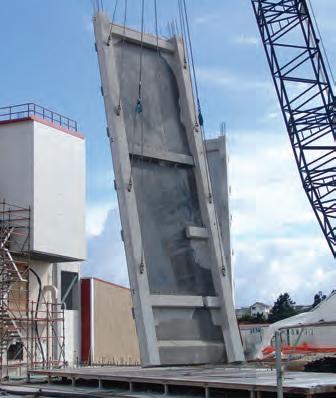
6 minute read
National Precast member profile
REID: 100 YEARS
OF REINFORCING THE INDUSTRY
REID CONSTRUCTION SYSTEMS HAS BEEN PROVIDING INNOVATIVE CONCRETE AND REINFORCING SOLUTIONS ACROSS AUSTRALIA AND NEW ZEALAND FOR A CENTURY. IN THIS NEW SERIES FEATURING NATIONAL PRECAST CONCRETE ASSOCIATION’S MEMBERS AND INDUSTRY PARTNERS, WE SPEAK TO REID’S HEAD OF MARKETING AND ENGINEERING, CHRISTALLO KOURIS.
Q: Could you please provide an
overview of Reid Construction Systems and its history?
A: The Reid brand has a 100-year legacy of safety, innovation, compliance and productivity. If Reid was a person, they would have lived through World War II, survived the Great Depression, and overcome not only the challenges faced during the first 30 years of their life, but also the adversity of today’s environment.
Reid has long held its values over time, which has allowed the business to prosper and continue to deliver to market concrete construction solutions to increase efficiencies within the building process. With a strong team of engineers and innovators, Reid continues to lead the industry in reinforcing, lifting, bracing and anchoring solutions.
Starting out in 1921 selling wire rope, today Reid is part of the broader Reid Construction Systems business with major manufacturing hubs in Melbourne and Brisbane, and offices/ warehouses/representation throughout Australia and New Zealand.
In 1977, Reid entered the precast concrete market with the introduction of the Swiftlift lifting system, creating an appetite for continued growth and moving into reinforcing with the ReidBar System in the 1990’s.
One of the highest priorities for Reid Construction Systems moving forward, is how it will work with the market, regulators and customers to shape the future of precast and concrete construction. And this is what excites the team most.
Q: How long have you been a partner with the National Precast Concrete Association Australia and why is the partnership important to you?
A: Reid has been a long-standing member of National Precast since 1991. Reid was also instrumental in the development of the Industry Partner membership category, of which Reid was the inaugural partner in 2015.
Our partnership with National Precast has prospered for 30 years, and Reid values the interactions and feedback from the National Precast members. We see this as the cornerstone of being able to provide market leading solutions and services. It has enabled Reid to become the leading innovator in the precast space, and communicate important information across to precasters and their industry partners, predominantly around compliance and safe lifting requirements.
More recently, engineering reforms have been introduced in some states of Australia, and we have relied on our partnership with National Precast to better understand the implication of these to our customers. The networking events and National Precast’s relationships with key regulators has been invaluable in helping us determine how we can better support our market and grow with our partners.
Q: What are some of the innovations happening within the precast industry and how is your company contributing to those?
A: Emerging trends in precast application include the creation of concrete structures through the formation of unique precast shapes and sizes, patterns and colours.
Precast is becoming more popular with architects, and also within the growing civil sector, due to its versatility and the opportunity for the designer to express their individuality, allowing for bespoke and aesthetically pleasing design.
Reid Construction Systems has its own in-house engineering design team who design and certify how concrete elements need to be lifted in accordance to relevant standards and safety procedures. We have seen a significant shift from standard, cookie cutter element design to more complex structures, requiring unique lifting solutions. Our engineering team is highly qualified, and sought after by large builders and developers, who build unique structures within the residential, commercial and civil
Christallo Kouris, Head of Marketing and Engineering at Reid Construction Systems.

Reid’s graphic concrete technology used on the wall of Yatalla Prison in South Australia.
market sectors.
The relationships held with key industry stakeholders including architects, engineers, developers and builders, allows Reid to continually innovate and develop a pipeline of solutions to cater to these emerging trends. One of these is graphic concrete within our architectural offer, which allows for custom made patterns and images to be executed onto the surface of precast elements.
In our core business of lifting technologies, Reid is continuously innovating its patented Swiftlift system, to ensure safe and effective lifting of unusual, large scale concrete panels, and we can’t wait to share some of our new innovations with the market throughout 2022.
Q: In your opinion, what are some of the biggest issues facing the precast industry and what are your answers to them?
A: I wouldn’t call it so much as an issue, but more of a challenge, or even an opportunity, and that is the increasing compliance requirements for engineers, and the focus on safety throughout the supply chain. Now in place across Queensland, New South Wales and Victoria, the legislation requiring the registration of engineers is a challenge for precasters, as the temporary works designs are now required to be signed-off by a Chartered Professional Engineer (CPEng) or equivalent that has been registered in the relevant state. Some states also require engineers to have Professional Indemnity (PI) Insurance, which has been harder to obtain due to exponentially increasing premiums in a high-risk industry.
Reid Construction Systems, as part of the wider ITW Group, is able to leverage and provide PI Insurance to all of our engineers. We reduce the risk for precasters by ensuring that qualified CPEng and registered engineers are designing and signing-off on lifting design, with a wider group of compliance and R&D engineers also employed by the business and available to provide advice for bespoke and complicated design.
Supply chain issues remain a challenge as lead times for product coming from overseas has doubled, and will likely worsen moving into next year. This can impact a precaster’s schedule and cause significant delays and increased costs. Reid Construction Systems manufactures locally and has a strong global supply chain for imported products. Reid has been able to minimise, as much as possible, the supply chain impact on product during this COVID period, giving our precast partners peace of mind that using Reid products will reduce the risk of project delays.
Q: What is your vision for the future of precast?
A: There are endless possibilities for precast. Over time, precast has grown to be a widely accepted building method, and we believe this growth will continue, particularly within the civil space. With this, it will be important to continue to build the precast architectural offer, with a focus on sustainability. In addition to civil and architectural, other emerging markets include precast flooring, where concrete provides cost and environmental benefits.
As the world, including Australia, addresses the need to tackle climate change, precast will no doubt play a part in providing solutions towards energy saving and environmentally beneficial building methods.
For Reid, the future involves engaging with the industry to recognise precast as the most attractive building element through safety, compliance, quality, productivity and versatility of design. Our vision is to continuously remain at the forefront of the industry when it comes to leading edge innovation, technology and construction solutions.

Reid has a long history of providing the industry with concrete lifting products.










